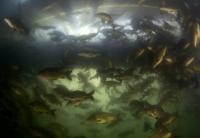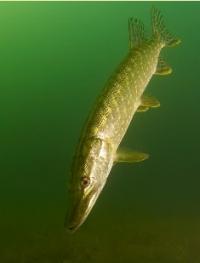Вы здесь
Ichthyofauna Ural River.


Tours in the West Kazakhstan region.
"And the songs of the fleeting river
I hear from afar alread
From this eternal melody
Light as from the sun in the soul"
Anatoly Bolutenko.
Sights of the West Kazakhstan region.
In the Ural River, including its delta, where purely marine fish enter, 58 species and subspecies of local fish belonging to 16 families are known. At least 15 species of acclimatized and introduced into artificial reservoirs of the basin, from where they penetrated into the rivers, should be added to them.
Most Ural fish species belong to the cyprinid family, which makes up over 40% of the total number of species, followed by sturgeon, 10.5% of the total number of species, herring - 10.5, perch - 7, salmon - 5.2. Families of pike, co, cod and some others are each represented by one species.
In general, the Urals has a typical freshwater European ichthyofauna. There is not a single species in it that would not be found, for example, in the Volga basin. And, on the contrary, a number of Volga species are absent in the Urals.
The relative species poverty of the ichthyofauna of the river is due to the fact that the Ural basin was repeatedly affected by the offensive of the Caspian Sea, and one of them, Akchagyl transgression, penetrated the Urals almost to the upper course.
n analysis of the composition of the Ural ichthyofauna indicates that the population of the Urals by fish occurs from the south and from the west. The species that are represented in the Caspian Sea as continuous forms penetrated the river.
Among them: asp, bream, common carp, pike perch. It is also believed that the Ural river roach, descended from roach. The offensive of the Caspian Sea facilitated the advance of semi-passage fish that populated all the water bodies of the middle part of the basin.
During the transgressions, apparently, penetrated the Urals from the sea. The list of typical freshwater fish (most small cyprinids) of the Urals indicates its close connection with the Volga basin. And this is not surprising.
The upper reaches of many rivers of two neighboring basins are very close to each other. In the mountainous part of the interfluve, there are lakes that until recently had runoff to both basins. In addition, in the Volga-Ural interfluve, the upper reaches are known - bifurcation of channels.
Currently, the most common commercial fish species in the middle reaches of the Urals are bream, pike perch, asp, ide, and roach. Sazan became very rare in the Urals, in the past it occupied first place in catches.
The disappearance of the carp is associated with mass deaths in the 50-60s of the last century, caused by industrial pollution of the Urals, as well as a change in the hydrological regime of the river. Intensive fishing, and then killing led to the almost complete destruction of producers of this species.
A significant influence on the Ural population of common carp had a number of shallow years, as well as the creation of the Iriklinsky reservoir. The rapid decline in spring floods during the cold period of spring led to the fact that even surviving carp producers did not find conditions favorable for spawning.
The ecological niche of common carp in the Urals, apparently, was occupied by the now-flourishing silver carp, which had hardly been seen before in the Urals. Typical species for the Urals are burbot and catfish.
Burbot is found from Uralsk to the upper reaches, and catfish is ubiquitous, including in small rivers in whirlpools with running water. In the Urals, ideal conditions are for catfish: deep reaches, silted backwaters, rich forage base.
In the middle reaches of the river to date, amateur fishers catch catfish weighing 100 - 120 kg or more. And historical data and preserved skeletons indicate that under favorable conditions, catfish in the Urals grew to 3 - 5 m in length and 3 centners of weight.
The unique composition of the ichthyofauna is characteristic of mountain rivers in the upper reaches of the Ural basin. Trout and grayling live in clean streams. Among the new species that came to the Urals from the Iriklinsky reservoir, we mention whitefish and European cisco (Coregonus albula).
Interestingly, in the Iriklinsky reservoir, and through it in the Urals, a Caspian igloo-fish appeared, brought from the lower Urals and the Caspian along with fodder organisms and producers of commercial fish species.
In the middle course of the Urals, a mottled silver carp penetrated from fish ponds. In the Urals, he does not spawn, but for a long time lives and grows to large sizes. For example, silver carp weighing up to 30 kg are often caught at the mouth of Belogorskaya Staritsa in the Tashlinsky district of the Orenburg Region.
A modern analysis of the ichthyofauna of the Ural River indicates a significant reduction in the number of individual valuable fish species. The reasons for this are intensive recreational fishing, poaching, changes in the hydrological regime of the river
The death of fish from kills caused by pollution has declined significantly in recent years. The measures taken to protect natural resources and fish stocks, preserving the natural regime in the middle and lower reaches of the river allow the Urals against the general background of other European rivers, like two or three centuries ago, for one of the rivers in Russia.
Authority:
A.A. Chibilev. "The Ural River." Leningrad. Hydrometeoizdat, 1987.







